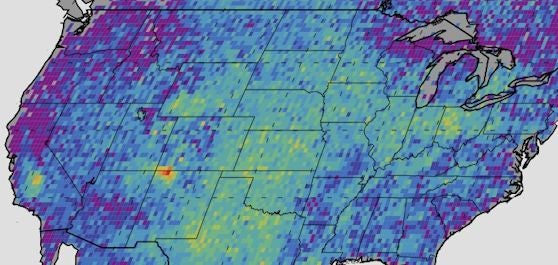What the New NASA ‘Hot Spot’ Study Tells Us About Methane Leaks

Look up in New Mexico and on most days you’ll see the unmistakable blue skies that make the Southwest so unique.
But there’s also something hovering over the Four Corners that a naked eye can’t detect: A 2,500-square mile cloud of methane, the highest concentration of the heat-trapping pollution anywhere in the United States. The Delaware-sized hot-spot was first reported in a study two years ago.
At the time, researchers were confident the cloud was associated with fossil fuels, but unsure of the precise sources. Was it occurring naturally from the region’s coal beds or coming from a leaky oil and gas industry?
Now a team mainly funded by NASA and the National Oceanic and Atmospheric Administration has published a new paper in a top scientific journal that starts to provide answers. They find that many of the highest emitting sources are associated with the production, processing and distribution of oil and natural gas.
For this study, the authors flew over a roughly 1,200-square-mile portion of the San Juan Basin and found more than 250 high-emitting sites, including many oil and gas facilities. They also noted that a small portion of them, about 10%, were responsible for more than half of the studied emissions.
This does not come as a big surprise. In 2014, according to industry’s self-reported emissions data, oil and gas sources accounted for approximately 80% or methane pollution in the San Juan Basin. The findings are also very consistent with results from one of EDF’s methane studies in Texas’ Barnett Shale, which also found disproportionate emissions from super emitters.
Finding super emitters
Since “super emitters” can and do appear anywhere at any time, it is critical to be constantly on the lookout for them so they can be fixed.
The good news is because of the outsized contribution of a fraction of sites, the authors note that reducing these emissions can be done cost-effectively through improved detection practices.
That’s consistent with what we know from a vast and growing body of methane research. And it means we can make a big dent in the methane cloud.
$100 million in wasted natural gas a year
Of course, that leaking methane isn’t just climate pollution; it’s also the waste of a finite natural resource.
In New Mexico, the vast majority of natural gas production takes place on public and tribal owned lands – meaning that when gas is wasted, it represents a tremendous amount of lost revenue for state and tribal governments. The San Juan Basin is responsible for only 4% of total natural gas production in the country, but responsible for 17% of the nation’s overall natural gas waste on federal and tribal lands. In fact nearly a third of all methane wasted on public and tribal lands occurs in New Mexico.
A report by ICF International found that venting, flaring and leaks from oil and gas sites on federal and tribal land in New Mexico, alone, effectively threw away $100 million worth of gas in 2013 – the worst record in the nation. That, in turn, represents more than $50 million in lost royalties to taxpayers over the last five years.
Nearby, we see a different story
Capturing methane and preventing waste at oil and gas operations on federal lands is an opportunity to save a taxpayer-owned energy resource while at the same time tackling a major source of climate pollution.
Over the past year, the Bureau of Land Management, which oversees federal and tribal lands such as those in the San Juan Basin, has moved to limit methane emissions. The agency based its action in Iarge part on experiences from New Mexico’s neighboring states, which have started to use modern practices and technologies to dramatically reduce this waste.
In 2013, San Juan Basin operators reported almost 220,000 metric tons of methane emissions. By comparison, Wyoming’s Upper Green River Basin has almost twice the natural gas production of the San Juan Basin, but only half the emissions.
Why the difference? Wyoming, like Colorado, has worked to put strong new rules in place to reduce emissions. And they are working.
Strong rules from BLM can do the same, but they must be completed and implemented quickly – to better protect the Land of Enchantment and federal and tribal lands across the U.S.
Image credit: NASA/JPL-Caltech/University of Michigan











